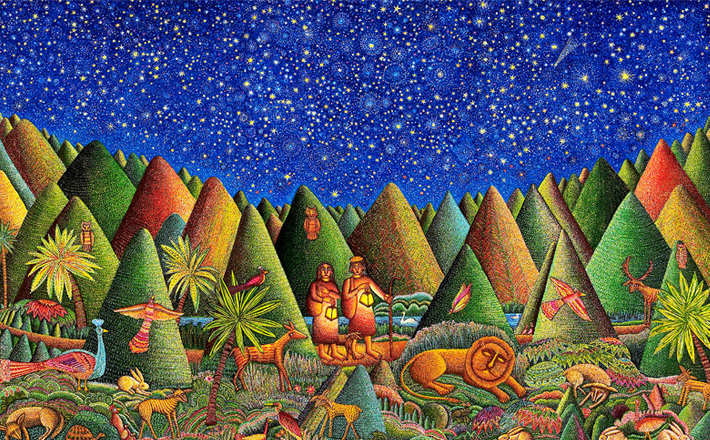Commentary on John 1:19-34
The image many of us have of John the Baptist comes from his memorable depiction in the Synoptic Gospels (Matt 3:1-12; Mark 2:2-8; Luke 3:1-20).
He appears in the desert as a fiery prophet, an Elijah-like figure who wears clothes made of camel’s hair, eats grasshoppers and honey, preaches a message of repentance, and baptizes all who take his message to heart.
The Baptist we find in John 1:19-34 is a bit different, however. His introduction in verse 19 says nothing about his dress, his food, his message of repentance, or his baptizing activity. It focuses on his “testimony.”
The word “testimony” (Gk. martyria) refers to speech about what one has seen and finds prominent use in legal settings (both ancient and modern). Fittingly, a trial motif that runs through John’s Gospel (with Jesus being the one put on trial) is introduced in verses 19-28 with the arrival of priests and Levites sent to interrogate the Baptist.
They are sent by “the Jews,” a term the Fourth Gospel often uses for Jewish religious authorities based in Jerusalem, as it does here. Verse 24 specifies it was the Pharisees who sent them. Though Pharisees would not have had authority over priests and Levites at the time of John the Baptist and Jesus, John’s Gospel anachronistically projects such authority to them because Pharisaic rabbis represented Jewish authorities to the Johannine community (cf. 7:32, 45; 11:47, 57; 18:3). The location of this interrogation, Bethany across the Jordan (precise location unknown), is not the same as the Bethany near Jerusalem that forms the setting of later scenes in the Fourth Gospel.
The Jewish emissaries seek from John an answer to the question, “Who are you?” In response, John outright denies he is the Messiah. The narration puts on John’s lips what it had informed the reader in the prologue, that John himself is not the light (1:8). His denial is introduced in a redundant fashion (“He confessed and did not deny it, but confessed”) for emphasis. It underscores the importance of right identification of the Messiah, as is reinforced by John’s use of “I am not” in his response, which contrasts Jesus’ messianic use of “I am” statements later in the Gospel (e.g., 4:25-26).
Upon further questioning, John rejects his identification with two figures expected as messianic forerunners, Elijah (Malachi 4:5; Mark 8:28; 9:11) and a prophet in the tradition of Moses (Deuteronomy 18:15-18). This is a notable point of difference between John and the Synoptics, which associate John with Elijah (Matthew 11:14; 17:12; Mark 9:13; Luke 1:17).
In John’s Gospel, no category other than “witness to the light” suits John the Baptist, who in verse 23 quotes Isaiah 40:3 to identify himself as the medium through which testimony is spoken. The Synoptic accounts use this verse to describe John (Matthew 3:1-3; Mark 1:2-4; Luke 3:3-6), but by having John name himself as “the voice,” the Fourth Gospel calls attention to his primary role as witness, that is, one who testifies about what she or he has seen. In the Fourth Gospel, John prepares the way of the Lord not by baptizing but by testifying or witnessing to the truth he has seen in Jesus.1
When asked as to the purpose of his baptizing, John turns attention away from himself to Jesus. He mentions his baptizing activity briefly, and when he discusses it more fully in verse 31 (after the priests and Levites had left), he explains that its purpose is to witness to Jesus, “that he might be revealed to Israel.”
The bulk of his response in verses 26-27 is spent anticipating Jesus, who is present but unknown, who is to come after John, and whose significance exceeds John’s (untying sandals was a slave’s chore). John’s inquisitors are left with less knowledge of who John is (he is “the voice”) than who he is not (the Messiah, Elijah, the Mosaic prophet), and they are introduced to a figure they did not ask about in the first place, Jesus. John’s words and actions are wholly directed toward making Jesus known.
This is even clearer in verses 29-34. Jesus appears for the first time in the Gospel narrative, but John does all the talking. On this “next day,” Jesus is there simply to provide the catalyst for John’s testimony, for John’s “voice.”2 In contrast to the first day of John’s testimony, no audience is specified. John speaks to anyone willing to listen, testifying to Jesus’ christological and soteriological significance before Jesus takes an active role in the story. John’s witness here will be developed and unpacked over the course of the Gospel.
According to John, Jesus is “the Lamb of God who takes away the sin of the world.” The lamb imagery is reminiscent of Revelation 5 and blends the depiction of the suffering servant in Isaiah 53:4-7 with the paschal lamb sacrifices that commemorated God’s salvation of the Israelites from slavery in Egypt (Exodus 12; cf. 1 Corinthians 5:7).3
John’s Gospel presents Jesus, who in John is crucified at the same time as the lambs are slaughtered for Passover (19:14), as another saving act of God, this time to liberate the world from sin. “Sin” in verse 29 is singular, signifying that according to the Fourth Gospel’s soteriology, Jesus’ messiahship is salvific not because he saves believers from individual sinful acts but because he liberates from the sinful human condition that alienates all people from God.4
To downplay his own importance, John also tells about Jesus’ preexistence, a christological claim introduced in the prologue (1:1-3) that appears elsewhere in the Gospel (8:58). Though John appears first in the Gospel story, Jesus has priority over John both in status and time (cf. verses 15, 27).
Using imagery familiar from the synoptic baptism accounts (though without admitting that John baptized Jesus), John says he saw the Spirit descend from heaven like a dove and “remain” on Jesus. He uses the perfect tense to introduce what he saw (“I have seen”), which indicates the Spirit still remains with Jesus (in Greek the perfect tense denotes a past action that still has its effect).
This, along with John’s testimony that Jesus “baptizes with the Holy Spirit” reflects the Fourth Gospel’s pneumatology. God’s Spirit remains with Jesus until Jesus himself passes it unto the believer (20:22). John ends his testimony by identifying Jesus as “the Son of God” (verse 34), one of the key christological affirmations of the Fourth Gospel (1:14, 18, 49; 5:19-27; 11:27).
John 1:19-34 presents John the Baptist as having a clear sense of who he is and who he is not, of his role in manifesting God’s work on earth, of God’s presence and revelation when he sees it, and of his life’s work as a testimony to that revelation. He baptizes not to cleanse people from sin but to witness to God’s presence in the world.
The John the Baptist we find in John’s Gospel shows how what we do reveals to others what we believe. Have we reflected on our individual identities enough to have a sense of the talents we have, and those we do not have, to carry on the work of God in our own particular contexts? Are we aware of the sort of God we reveal to the world by our words and actions? Do our acts witness to a God who takes away that which alienates people from God and each other, and does so not by militant violence but by sacrifice? Do they reveal a God who remains present in the world?
Or do our acts witness to a different sort of God altogether? The presentation of John the Baptist in John 1:19-34 challenges us to examine how our actions testify to our beliefs and what beliefs it is that they present to the world.
Notes:
1. Gail R. O’Day and Susan Hylen, John (Westminster Bible Companion; Louisville, Ky.: Westminster John Knox Press, 2006), 29.
2. Francis J. Moloney, The Gospel of John (Sacra Pagina 4; Collegeville, Minn.: Liturgical Press, 1998), 53.
3. For an extensive discussion of the background to the lamb imagery of 1:29, see Raymond E. Brown, The Gospel According to John (2 vols.; Anchor Bible 29-29A), 1:58-63.
4. O’Day and Hylen, John, 30.
PRAYER OF THE DAY
Glorious God,
Help us to hear when your chosen voices proclaim the work of your son, Jesus Christ, who lives and reigns in this world and the next. Amen.
HYMNS
Cold December flies way ELW 299
There’s a voice in the wilderness ELW 255
CHORAL
Nunc dimittis, Rene Clausen


December 29, 2013